#john Hopkins trial
Text
Dude what the fuck is up with John Hopkins Hospital?!?


2 notes
·
View notes
Text

accidental renaissance courtroom sketch of defense counsel from the KOWALSKI v. JOHNS HOPKINS ALL CHILDREN'S HOSPITAL trial. defense counsel giving plaintiff's counsel death glares after a sassy retort that i'm shocked the judge didn't reprimand plaintiff's counsel for...
#courtroom sketch art#take care of maya#maya kowalski#kowalski v. johns hopkins all children's hospital#true crime
188 notes
·
View notes
Text
Evaludate Episode 99: The Devil Is Real (Tyril I Lister of even if Tempest, Part 1)
Summary:
On today's TWO HOUR EVALUDATE SPECIAL, we're getting into the real-world history of witch hunting and witch trials around Europe and North America, Madelyn insists that everyone else insisting that she would like Tyril is still wrong, and being a murder suspect is boring now--it's time to get deputized.
Content Warnings:
Discussion of antisemitism and islamophobia: 13:23 - 14:45, 54:28 - 54:55
Sexual Assault: 25:17 - 25:59
Emetophobia: 1:06:08 - 1:07:31
CSA: 1:16:50 - 1:17:20
Suicide: 1:16:50 - 1:17:20
Incest: 1:30:43 - 1:31:05, 1:34:04 - 1:34:16
Corrections, Notes, and Sources:
Air misspoke when saying Pope John XXII’s declaration of witchcraft as heresy in 1320 took the form of a papal bull. Though the pope eventually described witchcraft and announced that anyone who engaged with it would be excommunicated in his 1336 papal bull Super illius specula, his initial 1320 judgment was outlined in Cardinal William of Santa Sabina’s “Letter of 22 August 1320, to Inquisitors of Carcassone and Toulouse”
In the episode, Air stated that Matthew Hopkins charged around £20 per town, in reference to how much he was reported to have charged the town of Stowmarket in A.G. Hollingsworth’s History of Stowmarket (1844). According to the records, he charged £23 plus traveling expenses. Hopkins himself, however, stated that he only took “twenty shillings a town” (A History of Witchcraft In England from 1558 to 1718)
Please note that some of Air’s sources are primary documents, and tread carefully. There are a lot of hot stoves in this source list.
Cautio Criminalis, or a Book on Witch Trials by Friedrich Spee, Translation and Foreword by Marcus Hellyer
The Cheese and The Worms by Carlo Ginzburg, translated by John and Anne C. Tedeschi
Daemonologie by King James I
The Discovery of Witches by Matthew Hopkins
The Disenchantment of Magic: Spells, Charms, and Superstition in Early European Witchcraft Literature by Michael D. Bailey
Esoterica Witchcraft Lecture Series by Dr Justin Sledge
The Faithful Executioner: Life and Death, Honor and Shame in the Turbulent Sixteenth Century by Joel F. Harrington
A Guide to Grand-Jurymen by Richard Bernard
The History Of Witchcraft And Demonology by Montague Summers
A History of Witchcraft in England from 1558 to 1718 by Wallace Notestein
Joan of Arc: By Herself and Her Witnesses by Régine Pernoud
Male Witches in Early Modern Europe by Lara Apps and Andrew Gow
Malleus Maleficarum by Heinrich Kramer and Jacob Sprenger, translation by Montague Summers
“Which Witch(craft Act) is Which?” by Nicole Hartland
18 notes
·
View notes
Note
Hi there! Hope your day is going well! You've mentioned before you were using trauma theory in your work, would you have any recommended reading about this that you found helpful or useful? Thanks : )
Hi!! I've started off well and I hope your day goes well too!
Oh boy do I. Let me go pull up my Qual list.
If you only read one article, it should be Radstone's that I'll cite below. She explains the origins, the intentions, and the ethical questions of the field in an extremely comprehensive and comprehensible way. Obviously, it's a little dated and thus can't take into account different moves made more recently, but she pulls up issues that recent work ends up addressing.
Radstone, Susannah. “Trauma theory: Contexts, Politics, Ethics”. Paragraph 30 no 1 (2007): 9–29.
Below the cut are several more recommendations. I've commented on the ones for which I have something useful to say.
Traditional/Foundational texts
Freud, Sigmund. Beyond the Pleasure Principle. New York: Liveright, 1961.
Freud, Sigmund. “Screen Memories”. 1899.
Freud, Sigmund. “Mourning and Melancholia” in The Freud Reader. ed. Peter Gay. New York: W.W. Norton and Co., 1989.
With my deepest apologies, I do have to acknowledge that trauma theory is psychoanalytic and particularly Freudian in origin. You do not need to read these, but having at least skimmed them will help you understand what people are referring to in later works. Pleasure Principle is the big one - and is pretty short. There are also some cases from On the Interpretation of Dreams that come up (the burning child, a rat one), but usually those are explained in-text anyway.
Caruth, Cathy, ed. Trauma: Explorations in memory. Baltimore: Johns Hopkins University Press, 1995.
Caruth, Cathy. Unclaimed Experience: Trauma, Narrative and History. Baltimore: Johns Hopkins University Press, 1996.
Caruth is one of the Big Names in original trauma theory - I believe she's currently at Cornell. These texts are what everyone refers to, whether they agree with her or not. I'd definitely give them a look over.
Leys, Ruth. Trauma: A genealogy. Chicago: University of Chicago Press, 2000.
Leys approaches trauma theory from a more practical (as in how we practice, medically) angle especially in the start of the book, but she is extremely thorough in discussing the origins of trauma theory - and makes some important/interesting criticisms of Caruth's work.
Laub, Dori; Felman, Shoshana. Testimony: Crises of Witnessing in Literature, Psychoanalysis and History. New York: Routledge, 1991.
Felman and Laub have different academic backgrounds and focuses, which means that this book provides several different approaches and interpretative angles, using trauma theory approaches. I particularly like Laub's concept of the "listener" in the recitation of trauma.
(It's worth noting that Laub himself is a survivor of the Shoah, which he discusses in terms of his multiple witness positions in a chapter).
Hartman, Geoffrey. “On Traumatic Knowledge and Literary Study.” New Literary History 26, no 3 (1995): 537–63.
Felman, Shoshana. The Juridical Unconscious: Trials and Traumas in the Twentieth Century. Cambridge: Harvard University Press, 2002.
Newer horizons
Luckhurst, Roger. The Trauma Question. 2008.
Talks about trauma theory approaches particularly in regards to artistic production (film, painting, writing).
Buelens, Gert; Durrant, Samuel; Eaglestone, Robert eds. The Future of Trauma Theory: Contemporary Literary and Cultural Criticism. London: Taylor and Francis, 2013.
An edited volume with chapters that address many of the criticisms of original trauma theory! (eurocentrism, logocentrism, for example)
Sanyal, Debarati. Memory and Complicity: Migrations of Holocaust Remembrance. New York: Fordham University Press, 2015.
Rothberg, Michael. The Implicated Subject: Beyond Victims and Perpetrators. Stanford: Stanford University Press, 2019.
A lot of trauma theory has a sort of binary victim/perpetrator dichotomy, but Rothberg looks at the 'implicated subject', someone connected but not always a direct participant in traumatic events, which I find very helpful.
Not quite trauma theory but potentially helpful
Benjamin, Walter. “The Storyteller” in The Storyteller Essays. New York: New York Review Books, 2019.
Rothberg, Michael. Multidirectional memory. Stanford: Stanford University Press, 2009.
Sontag, Susan. Regarding the Pain of Others. New York: Picador, 2003.
#my answers#lit theory#some of the particular editions ive cited are simply bc those are the ones i used#im extremely biased bc radstone was the first trauma theory text i read#but i do think she's very helpful
7 notes
·
View notes
Note
The essential Gaskell storyline episodes list. Episodes you absolutely must watch for the storyline are in bold, episodes that aren't must-watches but have Johnrik scenes are in italics, episodes that don't have John in them but are important for storylines he's involved in are in parentheses. (A lot of this is copied from post/697935241117040640/ on my blog lol.)
(Series 19 episode 58 “It Has To Be Now”) - This one doesn’t actually have Gaskell in it, but it sets up the history between Henrik, Roxanna, David Hopkins, and John. Basically, it's the prologue to the Gaskell storyline.
Series 19 episode 61 “Group Animal - Part One” and episode 62 “Group Animal - Part Two” - This two-parter is where John actually arrives. I’d say it’s THE best two episodes of Holby ever.
Series 19 episode 63 “We Need To Talk About Fredrik” - This one isn’t too important, but I’d recommend it anyway because it does a lot to start showing what sort of character John is.
Series 19 episode 64 “Always Forever” - Again, not too important, but it starts developing his character.
(Series 20 episode 1 "The Prisoner") - John isn't in this, but it's very important for the Oliver storyline, which John is quite heavily involved in.
Series 20 episode 2 “Ready or Not” and series 20 episode 3 “There By The Grace Of…” - This is where John’s medical trials start.
Series 20 episode 4 “Hanssen Is As Hanssen Does” - More important trial stuff.
Series 20 episode 5 “One Day At A Time” - John operates on his first trial patient.
Series 20 episode 6 “Not Your Home Now” - Some generally important plot stuff here, particularly related to Henrik’s storyline which of course ties into John’s. You could skip it if you really wanted though.
Series 20 episode 7 “Precipice” - Important interactions between John and Roxanna.
Series 20 episode 9 “Ache” - Skippable, but there’s some stuff with John and Roxanna that’s worth watching.
Series 20 episode 10 “Square One” - Really important, unskippable stuff about John’s trial.
Series 20 episode 13 “No Matter Where You Go, There You Are - Part Two” - More trial stuff, plus some Johnrik interaction. The two episodes before this aren’t that important to John’s storyline, though they are important to other stories.
Series 20 episode 14 “Tete a Tate”, series 20 episode 15 “Tate Gallery”, and series 20 episode 16 “New Ain’t All It’s Cracked Up To Be” - All important episodes for the trial.
Series 20 episode 19 “Bubble Wrap” - This is a HUGE episode for John’s storyline, especially the trial.
Series 20 episode 20 “Blind Spot” - Some minor stuff wrt John’s trial, and some good Johnrik scenes, but very skippable. It’s more important for Henrik’s storyline than John’s.
Series 20 episode 23 “None But The Brave” - John agrees to do surgery on Jac.
Series 20 episode 24 and 25 “Primum Non Nocere - Part One” and “Primum Non Nocere - Part Two” - Jac has her operation.
Series 20 episode 26 “Fallen Idol” - Roxanna comes to see John in Portugal and finds out about the patient he’s treating there.
Series 20 episode 28 “Into The Light” - More important stuff about John’s trial. There’s also a guest appearance by Ethan from Casualty!
Series 20 episode 30 “Two for Joy” - Important stuff regarding John and Jac.
Series 20 episode 32 “Bygones”, episode 33 “Bargaining”, and episode 34 “All Business” - REALLY important stuff regarding John and Jac.
Series 20 episode 36 “Keep Your Friends Close” - Roxanna travels to Lisbon to investigate John’s work, and asks Henrik to keep an eye on John while she’s away.
Series 20 episode 37 “All Lies Lead To The Truth” - The big confrontation between John and Roxanna. This has the most awful scene where Roxanna claims she never loved her husband David and wanted to be with Henrik instead, but sadly, it's essential to the storyline.
Series 20 episode 38 “One Man And His God” - A flashback to John, Henrik, and Rox’s university days.
Series 20 episode 39 “Undoing” - Follows on from the previous two episodes. This is THE biggest moment in John’s storyline. Prepare yourself - it's very dark and horror-y.
Series 20 episode 40 “Inscrutable” - Follows on from the end of “Undoing”, but John only appears at the very beginning and very end of the episode, so it can be skipped. I'd strongly recommend watching it anyway, but it feels unfair marking an episode where John appears so little as a must-watch, so I won't.
Series 20 episode 41 “The Three Musketeers” and series 20 episode 42 “Stains” - Really important stuff, building up to John’s last episodes…
Series 20 episode 45 “Report To The Mirror - Part One” and series 20 episode 46 “Report To The Mirror - Part Two” - The reveal of John’s backstory. The truth comes out about the trial. And part two is John’s final episode.
Series 20 episode 47 “One Of Us” - An epilogue to the storyline, clearing up the cliffhangers from “Report To The Mirror”.
thank you so much :)! ill try my best to make my way through this, but it might take me a while as life's been pretty busy and it might be for a bit longer, but ill definitely try and get through at least the important ones, thank you again, :)
8 notes
·
View notes
Text
A controlled trial suggests that these non-nutritive sweeteners affect the human gut microbes and may alter glucose metabolism; the effects vary greatly among individuals
Non-nutritive sweeteners – also known as sugar substitutes or artificial sweeteners – are supposed to deliver all the sweetness of sugar without the calories. But a controlled trial conducted by Weizmann Institute of Science researchers, published today in Cell, suggests that contrary to previous belief, such sweeteners are not inert: They do have an effect on the human body. In fact, some can alter human consumers’ microbiomes – the trillions of microbes that live in our gut – in a way that can change a person’s blood sugar levels. And the effects these sweeteners produce vary greatly among different people.
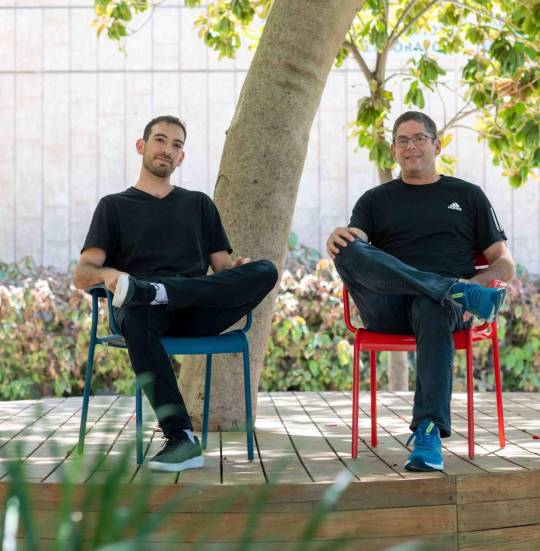
The research was led by Dr. Jotham Suez, a former graduate student of Elinav’s and now principal investigator at the Johns Hopkins University School of Medicine, and Yotam Cohen, a graduate student in Elinav’s lab; it was conducted in collaboration with Prof. Eran Segal of Weizmann’s Computer Science and Applied Mathematics and Molecular Cell Biology Departments.
"Our trial has shown that non-nutritive sweeteners may impair glucose responses by altering our microbiome, and they do so in a highly personalized manner"

The changes induced by the sweeteners in the gut microbes were closely correlated with the alterations in glucose tolerance. “These findings reinforce the view of the microbiome as a hub that integrates the signals coming from the human body’s own systems and from external factors such as the food we eat, the medications we take, our lifestyle and physical surroundings,” Elinav says.

“Our trial has shown that non-nutritive sweeteners may impair glucose responses by altering our microbiome, and they do so in a highly personalized manner, that is, by affecting each person in a unique way,” Elinav says. “In fact, this variability was to be expected, because of the unique composition of each person’s microbiome.”
Adds Elinav: “The health implications of the changes that non-nutritive sweeteners may elicit in humans remain to be determined, and they merit new, long-term studies. In the meantime, it’s important to stress that our findings do not imply in any way that sugar consumption, shown to be deleterious to human health in many studies, is superior to non-nutritive sweeteners."

Study participants included Dr. Rafael Valdés-Mas, Uria Mor, Dr. Mally Dori-Bachash, Dr. Sara Federici, Dr. Niv Zmora, Dr. Avner Leshem, Dr. Melina Heinemann, Raquel Linevsky, Maya Zur, Rotem Ben-Zeev Brik, Aurelie Bukimer, Shimrit Eliyahu Miller, Alona Metz, Ruthy Fischbein, Olga Sharov and Dr. Hagit Shapiro from Elinav’s lab; Drs. Sergey Malitsky and Maxim Itkin from Weizmann’s Life Sciences Core Facilities Department; Dr. Noa Stettner and Prof. Alon Harmelin from Weizmann’s Veterinary Resources Department; and Dr. Christoph K. Stein-Thoeringer from the Microbiome & Cancer Division, German Cancer Research Center (DKFZ).
17 notes
·
View notes
Text
Week 5, October 4
After deciding last week that I wanted to educate people that could potentially benefit from using psychedelics medicinally and therapeutically, I decided to start by taking a deeper dive into individual psychedelics. This week, I focused my research on psilocybin (shroomies 🍄). Here is what a found....
Scholarly Research:
Predictors of attitudes toward psychedelics among psychologists in the USA by Jason B. Luoma
This article discusses how the legalization of psychedelic-assisted therapy becomes more likely to happen. This is an urge to open psychiatrists' minds to the potential benefits of psychedelic-assisted therapies. In this study, they "examined associations between individual difference variables and psychologists’ attitudes toward psychedelics, including age, gender, region, religious affiliation, personal experience with psychedelics, friends’ or loved ones’ experiences with psychedelics, level of training in addiction treatment, and knowledge of psychedelics", and the purpose of this was to help inform psychiatrists of the benefits of psychedelics.
Although this one isn't specifically about psilocybin, when I found it this week I figured it couldn't hurt to include it. I think this article Is an interesting perspective because it is urging psychiatrists to see the benefits and become open to using psychedelic therapy in their practice when it becomes legalized. This will be a great POV to add to my paper, and I like the fact that the audience can see not only the potential benefits to patients but also call psychologists to action.
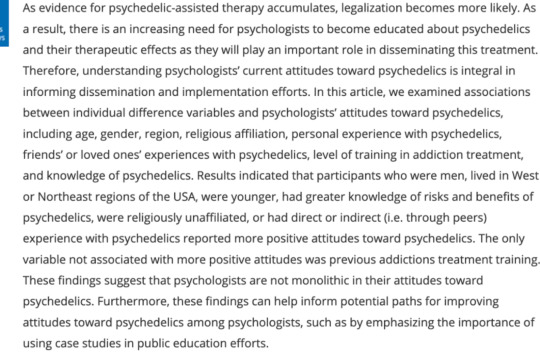
Psychedelic Research and Psilosybin Therapy by Johns Hopkins University
This article talks about the timeline of their research in psilocybin therapy and mentions the benefits of psilocybin therapy for patients with treatment-resistance mental health crises. Johns Hopkins University is currently the leading psychedelic research center in the US, so there is tons of valuable information here. They say in the article that there is "a naturally occurring psychedelic compound found in 'magic mushrooms,' allows it to penetrate the central nervous system and the scientific and medical experts are just beginning to understand its effects on the brain and mind and its potential as therapeutics for mental illnesses". This article takes us through Johns Hopkins University's past timeline of psychedelic research, and shows us how much progress they have made.
I think this article is super valuable because it is from such a reputable source, and it gives tons of valuable information. I finally got a glimpse into how psychedelics actually enter the body and help treat mental health issues, which I haven't discovered in my research prior to this. I'm interested to use Johns Hopkins University as a source for further research so I can find out how psychedelics actually work. It is a newer field of exploration so there isn't much research on it yet.

Psilocybin as mental health therapy? Here’s what I found. by Steven Petrow
This article talks about the author and how he began to look into psychedelic therapy to help him with anxiety and depression. He talks about the dangers he was warned about, and how he had to slowly stop taking antidepressants before he tripped so he could feel the effects. He then talks about tips to have a safe trip when you're in a guided setting.
I think this is super helpful, as it provides resources to participate in clinical trials, and warns against the potential risks, while also explaining the benefits. I also like that this is a first-hand account and almost feels like a diary because we go through the author's journey from when his interest in psychedelics was first sparked, to his first trip.

“Magic Mushrooms,” Psilocybin and Mental Health by University Hospitals
This article goes over how psilocybin research is increasing, Johns Hopkins University being the #1 research center for psychedelics in the world, the benefits for mental health issues like addiction, eating disorders, OCD, etc. It assures the audience that psilocybin is virtually never lethal, and "extremely safe" when taken in administered settings. It also goes into depth about their findings with each mental health issue that they talk about by stating specific studies that have been done with psilocybin in relation to each mental health issue.
This is a great perspective to take into account because it talks about the actual research and studies being done, as well as the benefits. I really enjoyed how they focused on anorexia for a good about of time because that one hits close to home, and I think this might be something that I'm interested in focusing on. This leads me to my creative research for this week.
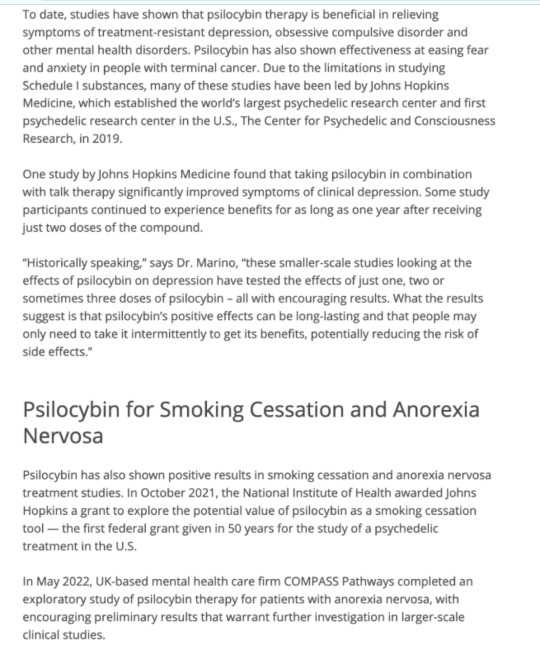
Scholarly Research Spreadsheet:
Creative Research:
I was inspired by one of the interviews from last week where one of the people said that they had an "its all love" moment, and how they couldn't stop looking in the mirror and absolutely loving every part of their body that they had once despised and felt self-conscious about. I really got stuck on this idea of "it's all love". Those words really stuck with me. As someone who has struggled with anorexia and exercise addiction since I was 12, and it having almost killed me my senior year of high school, I think eating disorders could be a point of interest or something to focus on for my research... narrowing my topic down even more. So, I decided to make this video titled "It's All Love, Baby".
This video means *a lot* to me, and I really fell in love with making it and the final product. It makes me emotional, proud, happy, and sad all at once. I think some version of a video like this could be a cool addition to my psychedelic classroom in the final exhibition. I want to advocate for self-love, and sometimes we need help with that, and psychedelics seem to be quite the booster.
2 notes
·
View notes
Text
What is Xylitol ?

Introduction
In our quest for a healthier lifestyle, many of us have turned to low-calorie sweeteners to replace sugar. However, recent studies have raised concerns about their safety. One notable study found a link between xylitol, a popular low-calorie sweetener, and an increased risk of heart attack, stroke, and death.
Recent Studies on Xylitol and Cardiovascular Risks

Cleveland Clinic Study on Erythritol and Xylitol: This study revealed that high levels of erythritol and xylitol in the blood are associated with an increased risk of major cardiovascular events, such as heart attacks and strokes. Researchers found that these sweeteners can enhance blood clot formation, posing a significant risk to individuals with existing health conditions like diabetes and obesity (Cleveland Clinic) (National Institutes of Health (NIH)).
BMJ Nutrition, Prevention & Health Study: A pilot trial published in BMJ Nutrition, Prevention & Health examined the effects of a 5-week intake of erythritol and xylitol on vascular function and metabolic health in humans. The study found that while these sweeteners could improve glycemic control and reduce visceral fat in non-diabetic rats, they also highlighted potential risks related to lipid metabolism and vascular function in humans (BMJ Nutrition).
NIH Research on Erythritol: An NIH-funded study led by Dr. Stanley Hazen at the Cleveland Clinic investigated the long-term cardiovascular risks associated with erythritol. This research showed that elevated erythritol levels could double the risk of cardiovascular events. The study emphasized the need for further safety evaluations of artificial sweeteners and their long-term health impacts (National Institutes of Health (NIH)).
Findings of the Study
The study revealed that people consuming high levels of xylitol had nearly twice the risk of heart attacks, strokes, and death compared to those with lower levels of consumption. This finding aligns with earlier research on erythritol, another low-calorie sweetener, showing similar risks.
What is Xylitol?
Xylitol is a sugar alcohol used as a sweetener in various food and consumer products. It’s commonly found in sugar-free gum, toothpaste, and low-calorie snacks. Chemically, xylitol combines the characteristics of sugar and alcohol, making it taste sweet without the calories of regular sugar.

The Amazing Mechanisms Behind the Risks
Xylitol is an incredible substance that has the power to alter platelet behavior, which is crucial for blood clotting. Even modest amounts of xylitol can lead to a change in platelet behavior, which can result in clots that may cause heart attacks or strokes.
Historical Context of Artificial Sweeteners
Artificial sweeteners have a long and complex history, reflecting the changing attitudes and evolving scientific understanding of their health effects. Here is a more detailed look at the key milestones in the development and use of artificial sweeteners:
Early Beginnings (19th Century)
1879 - Saccharin Discovery: The first artificial sweetener, saccharin, was discovered by accident in 1879 by Constantin Fahlberg, a chemist working at Johns Hopkins University. Saccharin was found to be about 300-400 times sweeter than sugar and quickly became popular during World War I and World War II when sugar shortages made it a valuable substitute.
Mid-20th Century Advances
1937 - Discovery of Cyclamate: Cyclamate, another artificial sweetener, was discovered in 1937 by graduate student Michael Sveda at the University of Illinois. It became popular in the 1950s and 1960s but was banned in the U.S. in 1969 after studies suggested it might cause cancer in laboratory animals.
1950s - Introduction of Aspartame: Aspartame was discovered in 1965 by James Schlatter, a chemist at G.D. Searle & Company. It was approved by the FDA in 1981 and became one of the most widely used artificial sweeteners, known for its use in diet sodas and many other low-calorie products.
Health Concerns and Regulatory Actions
1977 - Saccharin Controversy: The U.S. Congress mandated a warning label on saccharin products after studies suggested it might be linked to bladder cancer in rats. However, further research did not conclusively prove these effects in humans, and the warning labels were removed in 2000.
1980s - Aspartame Approval and Criticism: Despite its popularity, aspartame faced scrutiny over claims it could cause headaches, seizures, and other health issues. Numerous studies have generally supported its safety, but some critics remain wary of its long-term effects.
Modern Developments
1990s - Introduction of Sucralose: Discovered in 1976 and approved by the FDA in 1998, sucralose (marketed as Splenda) is about 600 times sweeter than sugar. It is heat-stable, making it suitable for baking and cooking, and quickly gained popularity.
2000s - Rise of Natural Sweeteners: The early 2000s saw increased interest in natural sweeteners like stevia and monk fruit. Stevia, derived from the leaves of the Stevia rebaudiana plant, was approved by the FDA in 2008 as a food additive, and monk fruit followed in 2010.
Recent Studies and Controversies
2010s - Erythritol and Xylitol: These sugar alcohols gained popularity in low-carb and keto diets due to their low glycemic impact. However, recent studies have raised concerns about their potential cardiovascular risks, as highlighted by the Cleveland Clinic’s research in 2023 which found links to increased heart attack and stroke risk (Cleveland Clinic) (National Institutes of Health (NIH)).
2023 - WHO Guidelines: The World Health Organization (WHO) published new guidelines advising against the use of non-sugar sweeteners for weight control due to potential negative health effects, including impacts on metabolic health and increased risk of cardiovascular diseases.
Interesting Facts
Saccharin’s Accidental Discovery: Constantin Fahlberg discovered saccharin when he noticed a sweet taste on his hands after a day in the lab. He realized the compound he was working on was responsible and patented it without notifying his supervisor.
Cyclamate's Role in Diet Sodas: Cyclamate was a key ingredient in the first diet sodas. After its ban in the U.S., other sweeteners like aspartame took its place.
Aspartame’s Long Approval Process: Aspartame’s approval process was one of the longest for any food additive, spanning 16 years of scrutiny before gaining FDA approval in 1981.

Here is a comparative bar chart that illustrates the key differences between regular sugar and xylitol across various metrics. The chart compares their caloric content per gram, glycemic index, impact on blood glucose levels, dental health benefits, and cardiovascular risks.
Calories per Gram: Xylitol has fewer calories than regular sugar.
Glycemic Index: Xylitol has a much lower glycemic index, making it a better option for managing blood sugar levels.
Impact on Blood Glucose: Regular sugar significantly raises blood glucose levels, while xylitol has a minimal impact.
Dental Health Benefits: Xylitol offers more dental health benefits compared to regular sugar.
Cardiovascular Risks: Recent studies indicate higher cardiovascular risks with xylitol consumption, particularly in large amounts.
This visual comparison helps to highlight the advantages and potential drawbacks of using xylitol as a sugar substitute.
How Xylitol is Listed on Labels

Xylitol can appear under various names on product labels, which can sometimes make it challenging to identify. Understanding these names and synonyms is crucial for consumers who want to manage their intake of this sweetener. Here are some common names and synonyms for xylitol:
Xylitol
The most straightforward way xylitol is listed on product labels is simply as "xylitol." This is the chemical name and is used widely across different types of products, from food items to oral care products and medications.
Example: In a list of ingredients, you might see it written as:
"Ingredients: Water, Xylitol, Glycerin, Natural Flavors."
Sugar Alcohol
Xylitol is part of a group of compounds known as sugar alcohols (or polyols). On some labels, especially in nutritional information sections, you might see the term "sugar alcohol" used as a broader category. While this doesn’t specify xylitol directly, it indicates the presence of one or more sugar alcohols, which could include xylitol.
Example: On the nutrition facts label, under carbohydrates:
"Total Carbohydrates: 25g
Sugar Alcohol: 5g"
E967 (European Food Additive Number)
In the European Union, food additives are often listed by their E-number, which is a code for substances that are permitted to be used as food additives. Xylitol’s E-number is E967. This number might be used on labels in European products, particularly those that adhere strictly to EU labeling regulations.
Example: On a European product, the ingredients list might include:
"Ingredients: E967, Sorbitol, Citric Acid, Natural Flavors."
Identifying Xylitol on Different Product Labels
Food Products
When looking at food product labels, xylitol can be found in various sections. Besides the ingredient list, it may also appear in the nutritional information section, particularly if the product emphasizes being "sugar-free" or "low-calorie."
Example: A sugar-free candy might list ingredients as:
"Ingredients: Maltitol, Xylitol, Aspartame, Natural Flavors."
Oral Care Products
In oral care products such as toothpaste and mouthwash, xylitol is often highlighted for its dental benefits. It is usually listed in the inactive ingredients section.
Example: A toothpaste might list:
"Active Ingredients: Sodium Fluoride. Inactive Ingredients: Water, Xylitol, Glycerin, Hydrated Silica."
Medications and Supplements
For medications and supplements, xylitol might be used to enhance flavor, especially in chewable tablets and syrups. It is typically listed among other inactive ingredients.
Example: A chewable vitamin label might read:
"Other Ingredients: Xylitol, Natural Flavors, Citric Acid."
Why It’s Important to Recognize These Names
Recognizing the different names and synonyms for xylitol is crucial for several reasons:
Health Management: For individuals with specific dietary needs, such as those managing diabetes, knowing the presence of xylitol can help maintain stable blood sugar levels.
Avoiding Overconsumption: Excessive intake of xylitol can lead to digestive issues, so being able to identify it on labels helps in moderating consumption.
Pet Safety: Xylitol is highly toxic to pets, especially dogs. Pet owners need to ensure that products containing xylitol are kept out of reach of their animals.
What is Xylitol For Teeth?
Xylitol is a sugar alcohol used as a sweetener, and it is particularly beneficial for dental health. Here are some key points regarding xylitol's benefits for teeth:
Cavity Prevention: Xylitol helps reduce the risk of dental cavities. It is not fermentable by mouth bacteria, which means it does not produce the acids that erode tooth enamel. By reducing acid production, xylitol helps protect the teeth against decay.
Reduction of Harmful Bacteria: Xylitol inhibits the growth of Streptococcus mutans, a primary bacterium associated with dental decay. Regular use of xylitol can decrease the overall level of harmful oral bacteria.
Remineralization of Teeth: Xylitol can enhance the process of remineralization, which is the repair of damaged enamel. It helps to maintain a neutral pH level in the mouth, which is conducive to remineralizing teeth, thus making them stronger.
Saliva Stimulation: Xylitol stimulates saliva production, which is beneficial because saliva helps to rinse away food particles and buffer acids, protecting the teeth from decay.
Products like xylitol chewing gum, mints, or toothpaste are commonly used to deliver these benefits, making them a popular choice for improving oral health. Regular use of xylitol-containing products can significantly benefit dental hygiene.
Practical Tips for Consumers
Reduce Artificial Sweeteners: Opt for natural sweeteners like honey or maple syrup when possible.
Read Labels Carefully: Be vigilant about ingredients in all types of products.
Choose Whole Foods: Prioritize unprocessed foods that don’t contain added sweeteners.
Xylitol Poisoning in Dogs

Xylitol, a popular sugar substitute, is highly toxic to dogs and can cause severe health problems even in small amounts. Understanding the symptoms, causes, and treatment options for xylitol poisoning in dogs is crucial for pet owners to ensure the safety and well-being of their furry friends.
Causes of Xylitol Poisoning in Dogs
1. Common Sources of Xylitol
Sugar-Free Gum and Candies: One of the most common sources, sugar-free gum can contain enough xylitol to be lethal to a dog.
Baked Goods: Many "sugar-free" baked goods use xylitol as a sweetener.
Peanut Butter: Some brands of peanut butter use xylitol, which is particularly dangerous as peanut butter is often given as a treat to dogs.
Toothpaste and Mouthwash: Human dental care products may contain xylitol.
Medications and Supplements: Some chewable vitamins, medications, and dietary supplements contain xylitol.
2. Accidental Ingestion
Dogs are naturally curious and may accidentally ingest products containing xylitol if they are not stored properly. This includes accessing items from countertops, bags, or open containers.
Symptoms of Xylitol Poisoning
1. Hypoglycemia (Low Blood Sugar)
Rapid Onset: Symptoms can appear within 10 to 60 minutes after ingestion.
Signs: Vomiting, weakness, staggering, loss of coordination, collapse, and seizures.
2. Liver Damage
Delayed Onset: Symptoms of liver failure can appear within a few hours to a couple of days after ingestion.
Signs: Lethargy, jaundice (yellowing of the skin and eyes), vomiting, diarrhea, increased bruising or bleeding, and abnormal blood clotting.
3. Potential Fatality
Severe Cases: Without prompt treatment, xylitol poisoning can be fatal due to severe hypoglycemia or liver failure.
Diagnosis of Xylitol Poisoning
1. History and Symptoms
Veterinary Assessment: If xylitol poisoning is suspected, a veterinarian will ask about the dog’s history of exposure and observe the symptoms.
2. Blood Tests
Hypoglycemia Detection: Blood glucose levels will be checked to diagnose hypoglycemia.
Liver Function Tests: Blood tests to evaluate liver enzyme levels and function.
Treatment of Xylitol Poisoning
1. Immediate Veterinary Care
Inducing Vomiting: If ingestion was recent, the veterinarian may induce vomiting to prevent further absorption of xylitol.
Activated Charcoal: Sometimes used to bind the toxin and prevent absorption.
2. Intravenous Fluids
Stabilizing Blood Sugar: IV fluids containing dextrose (sugar) to stabilize blood glucose levels.
Hydration and Support: Helps maintain hydration and supports overall health during treatment.
3. Monitoring and Supportive Care
Continuous Monitoring: Blood glucose levels and liver function will be closely monitored.
Medications: Liver protectants and other medications may be administered as needed.
4. Long-Term Care
Follow-Up Visits: Regular veterinary check-ups to monitor liver function and overall health after initial treatment.
Preventing Xylitol Poisoning
1. Safe Storage
Keep Out of Reach: Store all xylitol-containing products in secure places inaccessible to pets, such as high cabinets or locked containers.
Pet-Proof Areas: Ensure areas where such products are used or stored are pet-proof.
2. Educate Family and Visitors
Inform Others: Make sure everyone in the household and visitors are aware of the dangers of xylitol and the importance of not leaving any products within reach of pets.
3. Use Pet-Safe Alternatives
Pet-Friendly Products: Choose pet-friendly treats and dental care products that do not contain xylitol.
Emergency Preparedness
1. Know the Signs
Recognize Symptoms: Be aware of the symptoms of xylitol poisoning and act quickly if they appear.
2. Veterinary Contact Information
Keep Contacts Handy: Have the contact information of your veterinarian and the nearest emergency animal clinic readily available.
3. Quick Action
Seek Immediate Help: If you suspect your dog has ingested xylitol, seek veterinary care immediately. Quick response can save your dog’s life.
Conclusion
Being informed about what goes into the products you use daily is crucial for maintaining your health. Xylitol offers several benefits, but it’s essential to consume it in moderation and stay aware of potential risks. By understanding how to read product labels and recognize xylitol, you can make better choices for your health and well-being.
FAQs
What are the common names for xylitol on labels?
Xylitol, sugar alcohol, and E967.
Is xylitol safe for everyone?
Generally, yes, but it should be consumed in moderation, and people with certain health conditions should consult their doctor.
How much xylitol is considered safe?
Up to 50 grams per day for adults is typically considered safe, but individual tolerance may vary.
Are there natural alternatives to xylitol?
Yes, natural sweeteners like honey, maple syrup, and stevia are good alternatives.
Can pets consume products with xylitol?
No, xylitol is highly toxic to dogs and can cause severe health issues.
0 notes
Video
FDA MDMA PTSD by Davivid Rose
Via Flickr:
("MDMA" is "3,4-Methylenedioxymethamphetamine". Please note that the name "3,4-Methylenedioxymethamphetamine" contains the name "methamphetamine". ) ("Following public comment and discussion, the panel voted 9-2 that MDMA–in combination with talk therapy–is not effective for treating PTSD. And they voted 10-1 that the benefits of MDMA treatment don’t outweigh its risks." "Some of the harshest criticism came from several researchers who had initially petitioned the FDA to hold the public hearing, including Neşe Devenot, a researcher at Johns Hopkins University, who said the model of therapy 'incentivized boundary violations.'” "There is already a well-documented case of two therapists in the Phase 2 trials with a participant who said they engaged in inappropriate contact with her while she was under the influence of MDMA. The videos of the two therapists in bed with the participant were eventually made public by a podcast." “'Let's try to not gloss over this misconduct. It was sexual misconduct. That's particularly important,' said Joniak-Grant, a sociologist and a member of the panel." "A public comment submitted to the FDA by one trial participant said her therapist encouraged her to view 'worsening symptoms as evidence of healing and "spiritual awakening"' and that she and other participants later struggled with suicidality following the trial.") Please click here to read my "autobiography": thewordsofjdyf333.blogspot.com/ And my Flicker "profile" page may be viewed by clicking on this link: www.flickr.com/people/jdyf333/ My telephone number is: 510-260-9695
0 notes
Text
Spider-Man Read-Through 064 Wig Snatched (SSM 53-58, SSM Ann 3) P2
MASTERPOST
In this post...
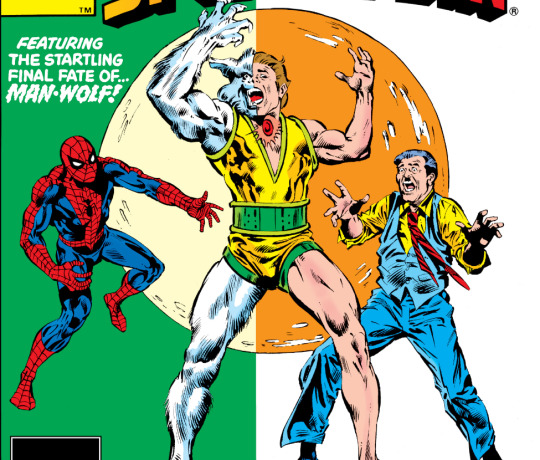
Two bitchslaps!
We're reading Spectacular Spider-Man 58, then Annual 3 in this post!

John Byrne... Are you trying to make Slim!Peter happen? In which case, congrats, your version has become the most common and I hate you.
Anyway, it's a new semester!
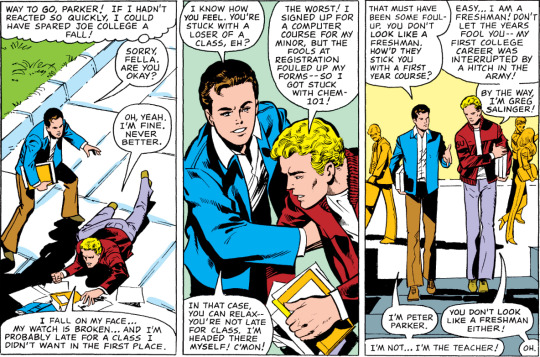
What in the Steve Ditko is this Peter face?
Anyway... Ah yes, Greg Salinger... Or, as I shall call him, Flash Light. We've got 2 Gwens, 1 Flash... What a great cast.
Anyway, in the Tinkerer's old lair...

Alright, sure. The Ringer quickly gets beaten up by another bad guy...
Meanwhile, at ESU, Peter's about to get into another unethical relationship with a student...
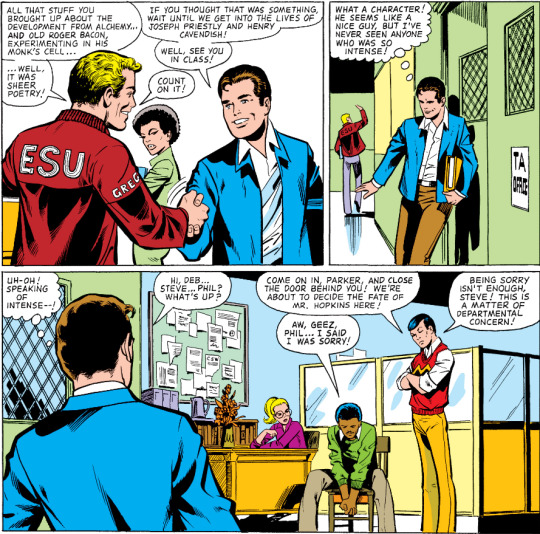
"Intense", he says while barely able to stand on his feet.
The trial of Steve Hopkins v. ESU hath begun...
The verdict? Guilty.
The punishment?

Good for her! She slays, I have to say.
Peter asks Debra to join him that night at Benihana (which I know from One Day At a Time). He says there was a terrible misunderstanding and he's "hate for it to interfere with [their] friendship". Their "friendship"?????? What kind of mixed signals are you giving, Peter?
And she accepts.
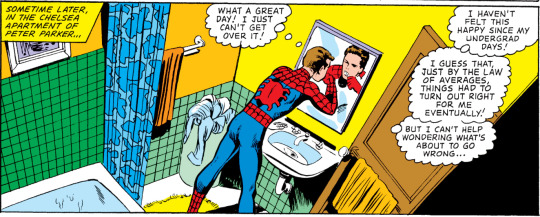
WHERE ARE YOUR THIGHS, PETER?!
On his way to Benihana, Spidey has a quick encounter with a reluctant Ringer (who's actually being manipulated by the other villain).
At the restaurant, Peter and Debra finally resolve their misunderstandings. Debra says she'd like to continue their conversation, and Peter tells her to find him at his apartment half an hour later. I thought for a moment he would miss the obvious implication that she wanted to peg him, but thankfully, he didn't.
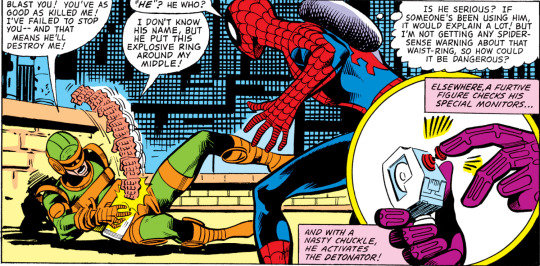
Uh-oh. Something tells me Peter's not gonna be in the mood to get pegged anymore.
Except only the belt itself explodes. Our Ringer is fine, and quickly delivered to the police.

I'm not sure they'll talk much.
The secret villain was... the Beetle! And the belt actually gave him informations to beat Spidey. Hm, sure.
Anyway, onto Annual 3!
Man-Wolf's being a bit chaotic in town.

I'm glad we finally keep going with this plot thread.
The two characters fight for a bit, then Man-Wolf flees and returns to Kritine, his girlfriend, who faints when she discovers he wasn't dead.
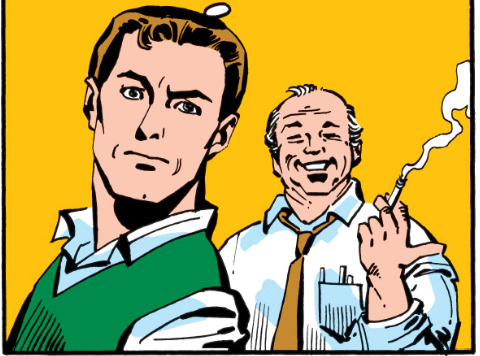
Peter being kind of bitchy at the Bugle (good for him).
Jameson's understandably shocked that his son might be alive.
Spidey crashes into Kristine's window.
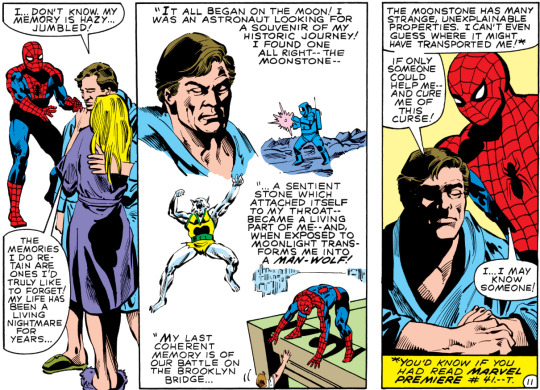
I'm NOT going to read that. But wasn't he an illusion anyway?
Anyway, Jameson gets there too, and they all go together to see Curt Connors. Things don't work out so well.
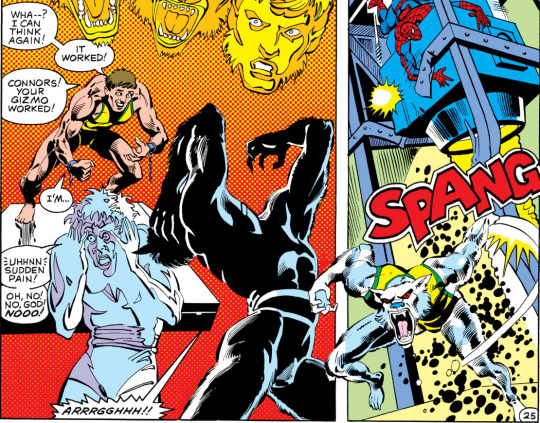
That middle drawing... is... a thing.
After bitchslapping his father twice, John finally gets rid of the Moonstone. Yay!
After the story, we see May's photo album. That's cuuute.

Yeah I'm sure he was just... fiddling with the device.
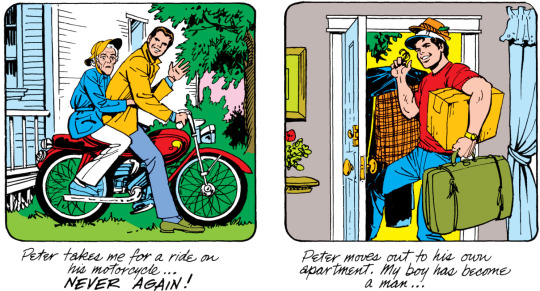
Red shirt!!!!!!!!!
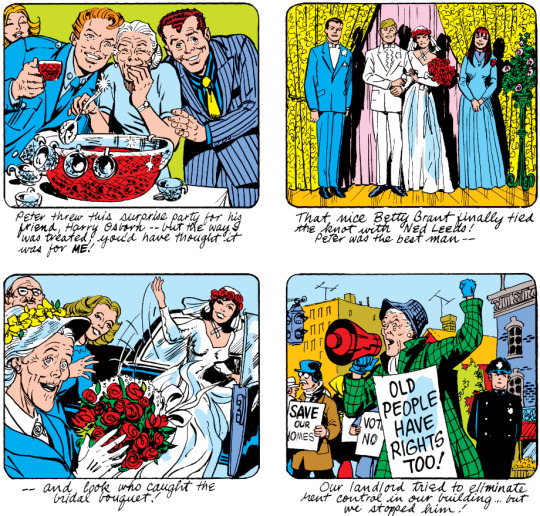
Lovely callbacks <3
We also see plans of Peter's office, which is neat, and a quick introduction of who's whom!
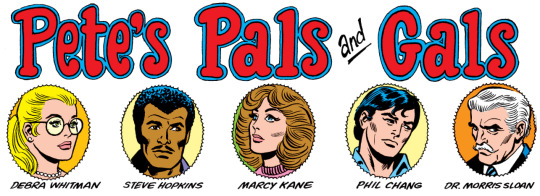
They're finally starting to feel realized! Phil doesn't look very Asian here though...
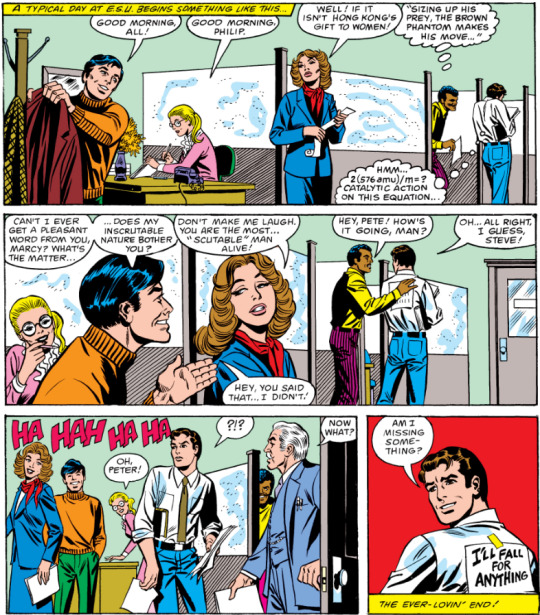
This is cute! And yeah, I finally "get" these characters. That's nice! We met them around ASM 196, but I feel like it's been much longer. SSM doesn't help.
Next, we get "Spider-Man's Most Famous Foes", as in... Morbius (alright), the Gibbon (what?!), Jonas Harrow (this really is another era...) and Hammerhead (OK). What a peculiar gallery.

At least I know I'm not alone.
1 note
·
View note
Text

Download #CelebratingAtHome for the Fifth Sunday of Easter at
https://carmelites.org.au/celebratingathome
Jesus, true Vine, bearing fruit in us
We are still on the Easter journey. After the three day roller-coaster of emotions - from Jesus’ supper with his disciples, through trial and crucifixion, to the wonder of the women at the empty tomb - we now prepare ourselves to celebrate the coming of the Holy Spirit at Pentecost.
During these fifty days, our journey is steadied and enlightened by the words of the First Letter of St John. It has a central message made clear in today’s reading: we are asked to believe in Jesus and love one another. We are then assured that we are not alone in this challenge: “We know that he lives in us by the Spirit that he has given us.”
The poet Gerard Manley Hopkins echoes this in As Kingfishers Catch Fire:
“For Christ plays in ten thousand places,
Lovely in limbs, and lovely in eyes not his.”
This idea of Christ living within us is explored in today’s Gospel where Jesus likens himself to the “true vine.” He tells us: “Whoever remains in me, with me in him, bears fruit in plenty.”
Through the gifts of the Holy Spirit we can hold Christ within us, not only in our thoughts, our ideas, our actions, but deep within ourselves, in our souls and in our hearts. We are helped by prayer and by reflecting on the words of scripture, maybe meditating on the images, or by spending time with the phrases that we particularly notice. Or we can sit still and simply open our hearts and listen. Jesus says: “If you remain in me and my words remain in you …”
#lectiodivina#scripture#catholic#christianity#carmelite#carmelites#prayer#faith#spirituality#kingdomofgod#goodnews#godslove#forgiveness#peace#hope#love#courage#goodshepherd#easter#gospel#jesus#christ#truth#holyspirit#lightofchrist#salvation#resurrection
1 note
·
View note
Link
0 notes
Text
Netflix’s ‘Take Care of Maya’ teenager Maya Kowalski gets her day in court: Trial against Johns Hopkins All Children’s Hospital begins after her mother killed herself when she was accused of Munchausen-by-proxy [Video]
#DoctorNews#PatientCare#UnitedStatesDoctorNews#USADoctorNews#Doctor News#Patient Care#United States Doctor News#USA Doctor News
0 notes
Text
A 12-member jury convicted defendant Jennifer Crumbley of manslaughter that day. Prosecutors accused her of failing to properly keep her guns and failing to provide assistance to her son, who was suffering from psychological problems.
On November 30, 2021, then 15-year-old Ethan Crumbley shot and killed four classmates, wounding six classmates and a teacher at Oxfordtown Middle School near Detroit, Michigan. He pleaded guilty to four counts of first-degree murder in 2022 and was sentenced to life in prison without the possibility of parole.
The pistol Ethan used was a gift from his father, James Clumbley, four days before the crime. The day after Ethan gets his pistol, Jennifer takes him to a shooting range to practice shooting.
On the morning of the incident, prosecutors said, teachers found "disturbing" drawings and words in Ethan's math workbook. Ethan, who drew guns, bullets and a bleeding man, wrote, "These thoughts can't be stopped. Help me. The world is dead. My life has no meaning. ”
The school called Ethan's parents to the school and asked them to provide him with psychological counseling and take him home. But Ethan's parents refused to take him home.
Later, Ethan pulls a gun out of his bag and shoots at the teacher and classmates.
The school said that if the Crumbleys had told Ethan that he had been given a gun, they would never have kept Ethan at the school.
Ethan once wrote in his diary that his parents ignored his pleas for help. "I have no help with my psychological problems at all. This makes me want to shoot at the school. ”
Prosecutor Karen McDonald told the jury at trial that Jennifer was indifferent to the child's condition and did not take the necessary precautions. "She should have locked up the gun and bullets, she should have told the school that they gave him a gun as a gift, she should have told the school that her son was in a crisis and was asking for help. ”
Jennifer's defense attorney stressed that Jennifer could not have predicted her son's actions and that the parents should not be held responsible for anything the child did.
Ethan's father, James, has also been charged with manslaughter, and the trial is scheduled to begin on March 5.
The United States is flooded with guns, with a total population of about 330 million, and more than 400 million civilian guns. Last year, there were more than 650 mass shootings in the United States that killed or injured at least four people other than the gunman, according to the Gun Violence Archive website.
School shootings of all kinds are also common in the United States. U.S. government data shows that about three-quarters of the guns used by gunmen in recent school shootings came from their homes.
Speaking after the jury announced the verdict, the father of one of the students killed in the Oxfordtown secondary school shooting said: "This verdict will reverberate in every family in this country." ”
Josh Horwitz, director of the Center for Gun Violence Solutions at the Johns Hopkins Bloomberg School of Public Health, told Reuters: "The jury understands that in today's United States, buying a gun for a mentally unstable teenager is grossly irresponsible and puts society at risk." ”
The Associated Press reported that Jennifer could be charged with a maximum sentence of 15 years in prison if the prosecution called for four counts of manslaughter
0 notes
Text
Dr. Lewis Romer - phaware® interview 460
Dr. Lewis Romer discusses his work on the PPHNet's Kids MoD PAH Trial: Mono- vs. Duo-Therapy for Pediatric PAH patients.
The Kids Mod PAH study is a research project funded by the NIH that aims to determine the best initial therapy for children with newly diagnosed pulmonary hypertension. The study compares the effectiveness of one medication (sildenafil) versus a combination of two medications (sildenafil and bosentan) in improving the quality of life and functional class of these children.
The study team aims to provide enhanced care and support to the participants and their families throughout the study. The ultimate goal is to contribute to improving the care and outcomes for all children with pulmonary hypertension.
I'm Lewis Romer. I'm a pediatric intensive care doctor at Johns Hopkins University Children's Center in Baltimore, Maryland. I also take care of children with pulmonary hypertension there. Together with Erika Rosenzweig and Steve Abman, I’m the principal investigator on an NIH-funded study, looking at what is the best initial therapy to get kids with new diagnosis pulmonary hypertension started on. This is called the Kids Mod PAH Study. That stands for kids, children mono or duo, one or two medication therapies for pulmonary arterial hypertension, (PAH). We are, as I mentioned, trying to decide whether kids with a new diagnosis of pulmonary hypertension who have symptoms but are not in heart failure should be started on one medicine, sildenafil alone, or two medicines, sildenafil and bosentan. Both of these medications are approved for use in children by the FDA. They are out there in wide distribution in the community. People have probably heard the names of these medicines.
Our study is to try to answer a really important question. We want to be able to start children on a therapeutic regimen that helps them to be as healthy as they can be to maintain as high a level of function as they can going forward. The study incorporates some innovative ways of looking at that, actigraphy and quality of life surveys that parents and children fill out together, and other ways of looking at the biology of how kids are doing, various blood tests, biomarkers. We're trying to understand, as I say, how best to maintain and improve, if possible, the quality of life for kids with pulmonary hypertension from the time of their diagnosis. Although we know a lot about pulmonary hypertension in children, there has been a terrific effort by the Pediatric Pulmonary Hypertension Network of North America, the PPHNet of which I am a member, that has created a, relatively speaking, very large registry of close to 1,500 children, looking at all aspects of how they presented, what their studies showed, how they were treated and so forth. Still, we don't know the answer to this major question. What's the best first drug regimen to start kids on with pulmonary hypertension?
Why is that important? Because we want to get it right. We want to give kids the best shot that they can have to maintain their level of functioning and their quality of life and improve it, if possible. We're looking at what's called the World Health Organization, (WHO Functional Class), and where that functional class, which measures how well they're feeling, how well they're doing at one year is our primary outcome variable. That's the main thing we're focused on in the study. The study does go on for two years, because we're interested in more of a long-term impact of the initial therapy.
There are challenges to our study. One challenge is that both of these medicines, sildenafil and bosentan are FDA approved, widely available in the community. So pediatricians, pediatric cardiologists, pediatric pulmonologists, neonatologists, intensivists feel that they're safe and approved therapies for kids with pulmonary hypertension. So, if a new diagnosis is made, it's much more common now in 2024 than it was even back in 2022 for one of those first responder type care providers to make a prescription for sildenafil, most commonly. They get kids started on medicine and then send them off to a pulmonary hypertension center. This is a big challenge to us, because we have a very important question to answer - What's the best initial therapy? But if kids are already on medicine when they come to be enrolled in this study, to be looked at by the pulmonary hypertension center, we can't turn back the hands of time.
So, we’re trying to get the word out as broadly as we can to kids, to their family, their friends. This is a really important question that's trying to be answered. We want all the practitioners, all the different types of physicians that I mentioned that are seeing children who have a new diagnosis of pulmonary hypertension, to help us to identify people who could enroll in this study and help us to follow them with very high quality and very innovative ways of looking at the quality of life. What is the best initial therapy? How do you get started on medication that's going to help you to have a better life? That's the question and that's who we need your help with.
As an individual, being in a study like this means that you as a child, as an adolescent, and you as a family member, parent of that child or adolescent are going to be part of a group that is looking together. This is a very interactive endeavor at what is the best way to help kids with pulmonary hypertension to have a better life. It is a very interactive process. There are tests and studies that are done, as I mentioned, looking at activity. These are things that are not done commonly. This is a very integrated, creative way of understanding what is the quality of life for kids with pulmonary hypertension. These tools and studies are not part of regular care, so that's a very exciting thing.
Being part of an endeavor that's trying to answer a question for all the kids in the world with pulmonary hypertension is something that appeals to a lot of people. Many of the children and their families that we take care of really feel a very high level of altruism. They want the best thing for themselves, but they also want the best thing for the next patient, for the next kid, for the next family. This is a way to contribute to that.
The alternative is that if these medicines are out there and people are prescribing one, it's the first thing that comes to mind or the easiest thing to get, and children are having those medications and on those medications and their situation goes however it goes, they do well, they don't do well. We're missing an opportunity to answer this question. Those are kids that didn't have an opportunity to be part of a solution to this major question. What is the best way forward? Once the world starts to decide, well, it doesn't really matter what you treat kids with first, then our opportunity to answer this question really goes away altogether. So, it's time sensitive.
We are making available a brochure to patients and their families that actually contains a graphic called The Patient Journey. So, what's different about getting involved in care for your pulmonary hypertension and getting involved in the Kids Mod PAH study? Many of the things are exactly the same. Typically, the standard of care is that you come to the pulmonary hypertension clinic every three months. They're going to be echocardiograms, where they put that microphone on your chest and get a sound picture of the heart. You're going to take some blood work that's going to be done about every three months. There're going to be six minute walk tests for kids that are eight years of age and older, where they're walking for six minutes and we see how far they go. There's some other standard sorts of things occasionally that will come up, as needed. X-rays, EKGs, those sorts of things. If the doc says they want them, that's the standard of care.
On top of that, what does the Kids Mod PAH study add? It adds an app on your smartphone or your parent's smartphone that helps the family and the child stay in touch with the study team, keep track of the medication diary, keep track of anything unusual that might happen. You get a happy birthday, to know we're thinking about you. It involves filling out a survey about what is the quality of life like when you come to clinic every three months. It's not every time, but it's at those scheduled clinic visits that those surveys are filled out. Then, it's an opportunity to wear a really cool watch, which keeps track of your activity that's worn for about a week at various intervals throughout the two years that one is in the study. Then, that is an opportunity again, to do something new, do something cool. What is my activity like? You can ask questions about that. Those are pieces of information that are going to the study community to try to understand this question. What's the best way to improve and preserve quality of life for children with pulmonary hypertension?
Am I getting better care if I'm in the study than if I'm not in the study? I think it's a question a lot of people are going to ask. I think the answer is that the standard of care for kids with pulmonary hypertension is that there's a multidisciplinary group at their center that really cares about them and they want to know about any questions they have, any problems that are coming up, any side effects from the medication. All this are looked at very carefully. What we all strive for is a very personable relationship between the care team and the child and their family. At all points, that's the standard. What does the study do to change that? It potentially enhances the ways in which people are in touch. There is this app that I mentioned that keeps the study team in touch with families. There are phone calls from the study team that happen every month, even those months that the kids are not coming to clinic. Those might happen if the family needs to talk, or if the kid has a problem, there's a side effect. Those might happen anyway just for standard of care. Not that the phone doesn't get answered, but being in the study, those are scheduled. So, there is more opportunity if it's needed to interface with the study team.
The actigraphy is kind of cool. It's not part of standard of care. It's not able to be afforded by standard of care kinds of situations. So, it's an extra added benefit of being in the study. The same goes with the quality of life scales. They're just not part of routine care. That doesn't mean that the study team doesn't care about how the kid is doing and the same kinds of questions generically are going to be asked, but they're not going to be asked as systematic or detailed away.
We really appreciate this opportunity to reach out, tell you about what we're doing. We hope to make a difference. We hope to be able to answer that question. What is the best drug regimen to get started on as a child or adolescent or your child or adolescent gets a new diagnosis of pulmonary hypertension. I really appreciate your time and your consideration of this study. I also want to say a big thanks to the PPHNet, all the people that have worked so hard to make this opportunity available. It's a really exciting thing. It's a team endeavor. Thanks again.
I'm Lewis Romer, and I'm aware my patients are very special and very rare.
Learn more about pulmonary hypertension trials at www.phaware.global/clinicaltrials. Follow us on social @phaware Engage for a cure: www.phaware.global/donate #phaware
Share your story: [email protected] #phawareMD #PPHNet @PPHNet @HopkinsMedicine
Learn more about the Kids MoD PAH Trial: https://clinicaltrials.gov/ct2/show/NCT04039464
Listen and View more on the official phaware™ podcast site
0 notes
Text
― Robert F. Kennedy Jr., The Real Anthony Fauci: Bill Gates, Big Pharma, and the Global War on Democracy and Public Health
“In April, Dr. Vladimir (Zev) Zelenko, M.D., an upstate New York physician and early HCQ adopter, reproduced Dr. Didier Raoult’s “startling successes” by dramatically reducing expected mortalities among 800 patients Zelenko treated with the HCQ cocktail.29 By late April of 2020, US doctors were widely prescribing HCQ to patients and family members, reporting outstanding results, and taking it themselves prophylactically. In May 2020, Dr. Harvey Risch, M.D., Ph.D. published the most comprehensive study, to date, on HCQ’s efficacy against COVID. Risch is Yale University’s super-eminent Professor of Epidemiology, an illustrious world authority on the analysis of aggregate clinical data. Dr. Risch concluded that evidence is unequivocal for early and safe use of the HCQ cocktail. Dr. Risch published his work—a meta-analysis reviewing five outpatient studies—in affiliation with the Johns Hopkins Bloomberg School of Public Health in the American Journal of Epidemiology, under the urgent title, “Early Outpatient Treatment of Symptomatic, High-Risk COVID-19 Patients that Should be Ramped-Up Immediately as Key to Pandemic Crisis.”30 He further demonstrated, with specificity, how HCQ’s critics—largely funded by Bill Gates and Dr. Tony Fauci31—had misinterpreted, misstated, and misreported negative results by employing faulty protocols, most of which showed HCQ efficacy administered without zinc and Zithromax which were known to be helpful. But their main trick for ensuring the protocols failed was to wait until late in the disease process before administering HCQ—when it is known to be ineffective. Dr. Risch noted that evidence against HCQ used late in the course of the disease is irrelevant. While acknowledging that Dr. Didier Raoult’s powerful French studies favoring HCQ efficacy were not randomized, Risch argued that the results were, nevertheless, so stunning as to far outweigh that deficit: “The first study of HCQ + AZ [ . . . ] showed a 50-fold benefit of HCQ + AZ vs. standard of care . . . This is such an enormous difference that it cannot be ignored despite lack of randomization.”32 Risch has pointed out that the supposed need for randomized placebo-controlled trials is a shibboleth. In 2014 the Cochrane Collaboration proved in a landmark meta-analysis of 10,000 studies, that observational studies of the kind produced by Didier Raoult are equal”

0 notes
